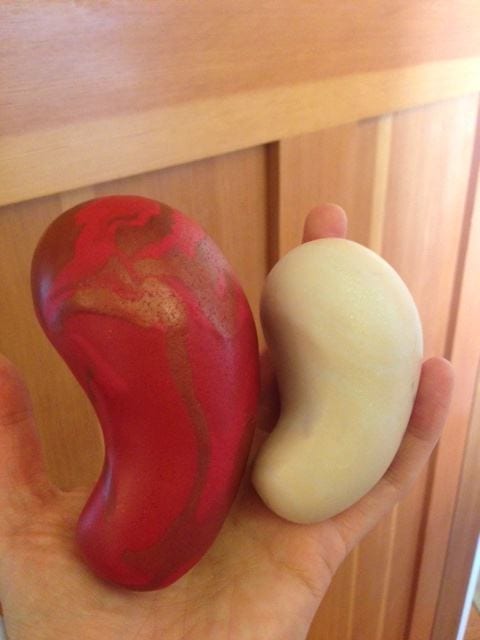Dyspareunia
Dyspareunia is the medical term for difficult or painful sexual intercourse.
There are many reasons for dyspareunia. So, it’s important to get a proper diagnosis. Most people automatically refer to a pelvic floor physical therapist for pelvic pain, which in most cases is a great idea. However, depending on the cause of pelvic pain, it may also be beneficial to work with a Visceral Manipulation™ practitioner, Abdominal Massage Therapist, an ND, or OBGYN.
Is there a pattern?
Knowing whether the pain happens cyclically or noncyclically, with certain sexual positions, just at the beginning of penetration, or only with deep penetration can help you and your doctor figure out the root cause of your pain.
For instance, when the pain is cyclical, right before your period, it may indicate pelvic congestion. The uterus gets heavier right before menses; imagine an eight-ounce mal-aligned uterus, and/or a growing fibroid, or hormonal imbalances that cause fluid retention and pressure on surrounding vessels, tissues and nerves. If you experience painful intercourse, keep a log of where you’re at in your menstrual cycle when you experience the pain.

Clay Womb Models. Red model is 8 oz. The white model is 4 oz.
Noncyclical pain unrelated to the uterine position may be due to bladder issues such as infections, herpes or eczema at/in the opening of the vagina, adhesions, inflammation, kidney issues, Lichen sclerosis, vulvodynia, or tumors. Again, it’s important to get a proper diagnosis, so visit your doctor!
Vaginal Pain: Post episiotomy scar tissue may cause pain just inside the vagina with penetration. So can tension in the pelvic floor muscles which may be caused by physical imbalances such as poor structural alignment (in the pelvis, sacrum, legs, or even the feet!), or spasms in the levators due to emotional or psychological triggers.

Vulvar Lichen sclerosus can lead to scarring strictures, atrophy, and fissures of the genitalia causing painful intercourse. In the early stages, it’s often confused with a fungal infection due to itchiness.
“Physical examination findings can vary widely in presentation and severity among patients (see Table 1).1 Typical vulvar lichen sclerosus characteristics may include hypopigmentation, atrophy, erythema, fissures, and purpura of the skin.6 These skin characteristics are often described as “parchment-like” or “cigarette paper” and…read more.
“The exact etiology of lichen sclerosus has not been ascertained; however, evidence points to an increased likelihood of an autoimmune and genetic component.4 In a study of 350 women with lichen sclerosus, researchers found that 21.5% had 1 or more autoimmune-related diseases, 21% had a family history of autoimmune disease, and 42% had autoimmune antibodies.4 The most common autoimmune diseases associated with lichen sclerosus are autoimmune thyroiditis, alopecia areata, vitiligo, and pernicious anemia. In addition to an autoimmune factor, it appears that genetics has a pathogenetic role as well. A study of 1,052 women with vulvar lichen sclerosus found that 12% of participants had a positive family history of lichen sclerosus.4 Trauma and chronic irritation have also been linked to being contributory factors of vulvar lichen sclerosus.4 Cases of the skin condition have been reported in patients with genital jewelry, postsurgical procedures, and genital trauma.” Read more at Sclerosus Vulvar lichen: breaking the silence
Women going through menopause may also experience pain with penetration due to hormonal shifts that cause vaginal atrophy and/or vaginal dryness. “In one cohort study (source 1) of women ages 40-55 years, the overall prevalence of vaginal dryness was 13.1%, but the prevalence of vaginal dryness was lower in the early menopausal transition, and increased across the transition.” Dr. Aviva Romm Botanical Medicine For Women’s Health. That’s right ladies, menopause doesn’t necessarily mean your vagina will dry up. And if it does, there are things you can do to remedy the situation.
Vaginal dryness does not just occur in menopause. Women of all ages experience vaginal dryness. Before reaching for vaginal lubricants, ask yourself if you and your partner are allowing enough time for physical arousal. Many couples don’t give enough time for foreplay.
“…it’s important to figure out why you’re experiencing dryness – it can be due to hormonal changes (especially declining or low estrogen), body products you’re using (irritating soaps or bath products, for example), diet (especially not getting enough good quality essential fatty acids), autoimmune disease (for example Sjogren’s syndrome), lack of enough foreplay and therefore lubrication, or, and this is a tough one, sometimes your sex partner just might not be turning you on (if you want to stay in that relationship, fantasy images and other options can help). Dr. Aviva Romm Read the full article here.
Irritants It’s worth mentioning that vaginal pain may be caused by herpes or some other condition that would be an irritant at the opening of the vagina. Douches, scented products, and sprays mess with your vaginal ecology, so avoid those at all costs! If you are trying to cover up a foul smell, please see your doctor for a diagnosis. If it turns out you have bacterial vaginosis, please read Dr. Romm’s article on BV. I also recommend avoiding bleached pads and tampons. Use organic tampons and pads, or cloth pads.
Pain with deep penetration may be caused by adhesions from a c-section scar. Shortly after a c-section, adhesions may form between the uterus and other tissues prohibiting the uterus from moving freely. During intercourse, the uterus should be able to move up and down with thrusting. If adhesions are present the uterus won’t move freely causing the tissues to tear!
Endometriosis adhesions on the broad ligament or uterosacral ligament can also cause pain with deep penetration from resulting tears.
“The Allen–Masters syndrome (AMS), first published in the 1950s of the last century [ 4 ], described a phenomena related to traumatic labor. These women have new pain, pressure, and profound dyspareunia, all related to vaginal labor. The syndrome includes hypermobile painful uterus, most of the time retroverted. Typical findings in laparoscopy include: deep and congestive Douglas pouch, peritoneal tears in the posterior leaf of the broad ligament with asymmetrical USL in some cases.” Pain Medicine, Volume 17, Issue 2, 1 February 2016, Pages 370–371
“This syndrome [AMS] may arise following childbirth which is too quick or too slow, or the application of forceps or suction which tears the cervix, perineum, or cardinal ligaments…Pain is low, median, and posterior, with a sense of heaviness. Pain is increased by sitting for long periods (tension of the sacrospinous and sacrotuberous ligaments and certain pelvitrochanteric muscles), by fatigue and by effort. Other symptoms include dysmenorrhea, premenstrual syndrome, and pain on deep penetration and orgasm. Symptoms are relieved by rest in the prone position.” -Jean Pierre Barral, D.O., pg 133 of Urogenital Manipulation
Uterine position and sexual position:
Ok, this section of the article took me a while to research. For some reason, I struggled with visualizing how, specifically, the mal-aligned uterus and surrounding structures are impacted by penetration. For several days all I could think about was sex, but in a very boring mathematical way, … penis angle relative to the vaginal slope and uterine position, velocity…Yes, I tend to overthink this kind of thing, I like to understand the mechanism, ligaments, and structures involved. The more I understand what’s actually going on, the better I can “see” with my hands through the belly layers during manual therapy treatment.

Margo the Wandering Womb helping me calculate the point of contact using penis angle average, vaginal slope, the degree of uterine position, and velocity.
After hours of calculating penis angle and vaginal slope possibilities and reading textbooks, I finally Googled “where does the penis tip contact during supine sexual position”. Unfortunately, some things I will never be able to unsee.
Of course, there are many variables to how a penis/dildo affects the internal structures but there are common pain patterns with mal-positioned uteri/cervix in relation to the sexual position, so it’s worth discussing.
For instance, when a female is supine (on her back) and has a retroverted uterus (tipped back) or retroflexed uterus (flexed back) she may experience pain with deep penetration. During sexual arousal, the uterus should move up away from the penis or dildo. Imagine a uterus that’s retroverted (tipped back toward the rectum) and adhered (stuck in place). With deep penetration, while in the supine position, the penis may naturally be directed to the posterior fornix (behind the cervix). This could cause pain from pulling or tearing of posterior adhesions. Even without adhesions present, deep penetration could cause pain if the penis pushes an already retroverted uterus further against the sacrum irritating surrounding nerves.
Retro uterus/ante cervix Typically (not always) when the uterus is retroverted, the cervix is in an ante (forward) position and may irritate the bladder neck. In this case, the prone (face down) position may be painful and cause urinary urgency during intercourse.
Uterine anteversion or anteflexion can also cause pain in the prone position during sexual intercourse. The cervix can move in the sagittal plane and either tip toward the rectum or tip forward toward the bladder with an anteverted uterus. So, because of the proximity of the cervix to the penis, the cervical position is sometimes more of an issue with painful intercourse than the uterus.
Side-lying Pain with side-lying sexual intercourse may indicate a side bending uterus. If tears in the broad ligament are present, side-lying may be painful regardless of penetration.
Basically, uterine and cervix alignment matters!
Circumcised Partners and Painful Sex: Just when I thought I was done thinking about penises for a while, a reader sent me several studies that indicated that the circumcised penis may be more irritating to the vagina than the uncircumcised penis for a number of reasons. In this study, they concluded, “Circumcision was associated with frequent orgasm difficulties in Danish men and with a range of frequent sexual difficulties in women, notably orgasm difficulties, dyspareunia and a sense of incomplete sexual needs fulfillment. A thorough examination of these matters in areas where male circumcision is more common is warranted.”International Journal of Epidemiology, Volume 40, Issue 5, 1 October 2011, Pages 1367–1381, https://doi.org/10.1093/ije/dyr104
The pelvic nerve branching is unique to each woman! Along similar lines of thinking, how we experience pleasure is unique to each woman. As Naomi Wolf explains in her book Vagina, “Among the many incredible things about your incredible pelvic nerve and its lovely multiple branches is that, as we saw, it is completely unique for every individual woman on earth—no two women are alike.”
“Every woman is wired differently. Some women’s nerves branch more in the vagina; other women’s nerves branch more in the clitoris. Some branch a great deal in the perineum, or at the mouth of the cervix. That accounts for some of the differences in female sexual response.” Many women were led to believe something is wrong with them if they don’t experience a vaginal orgasm. “Freud popularized the idea that there was a kind of quarrel between them [the clitoris and the vagina] in terms of female development, and that there are morally “better” and morally “worse” kinds of female orgasm. In his terms “mature women had vaginal rather than “immature” clitoral orgasms, a position with which his disciples would concur and extend into the mid-twentieth century-thus making many women of our mothers’ and grandmothers’ generation self-doubting along the way.”- Naomi Wolf
Could it be that women are having intercourse in a way that goes against their own pelvic wiring because they believe something is wrong with them? Are they having sex In a way that is portrayed in porn? Or how they think they should be having sex? Having intercourse in a way dictated by cultural beliefs can lead to painful intercourse not only by having rougher aggressive sex but how we think or feel about our vaginas actually changes the tissue response in the vagina, pelvic floor and the chemical response in the brain resulting in pain.
Naomi Wolf’s book Vagina: A New Biography is truly revolutionary. I think it should be required reading for every woman and man.
Feeling unsafe When a woman feels unsafe or threatened her sympathetic nervous system kicks in and blood is diverted away from the genitals and her pelvic floor constricts as her body prepares for fight or flight. “Based on the insights in Meston and Gorzalkas’s work, we now know that a threatening environment-which can include even vague verbal threats centered on the vagina or dismissive language about the vagina-can close down female sexual response.” -Naomi Wolf
When the female sexual response is shut down, but she has sex anyway because she thinks she’s “being too sensitive” or “needs to lighten up” painful intercourse may result due to tense pelvic floor muscles and lack of lubrication.
Birth Control Pills and Painful Intercourse! Allison Behringer talks about how birth control pills can cause painful intercourse in her Bodies podcast Episode #1 Sex Hurts Please listen to this episode, it’s really well done, educational and touching.
Low DHEA: From the article, Genitourinary Syndrome of Menopause in Breast Cancer Survivors on the Cleveland Clinic website: “After menopause, as the ovaries stop making estrogen from androstenedione, some production continues in other tissues, with DHEA as the primary precursor of androgens that are ultimately converted to estrogen. This has led to the theory that the cause of GSM is not estrogen deficiency but androgen deficiency. Evidence reviewed by Labrie et al11 shows that vulvovaginal atrophy is caused by decreased DHEA availability, which in turn causes sex steroid deficiency-related menopausal symptoms.11 Thus, it is reasonable to conclude that menopausal symptoms can be relieved by giving DHEA.”
To summarize:
Painful sexual intercourse may be caused by:
- pelvic floor tension or spasm
- vaginismus
- anxiety
- episiotomy scar
- pelvic adhesions from c-section scar or infection
- endometriosis
- mal-positioned uterus including prolapse
- infection
- herpes or eczema at the opening of the vagina
- chemical irritants
- urinary obstruction
- menopause (vaginal dryness and atrophy)
- pelvic congestion
- ovarian cyst
- traumatic labor and delivery
- skipping foreplay
- negative views regarding your own vagina and shame
- rough sex
- lack of communication with your partner
- feeling unsafe
- Lichen sclerosis
- birth control pills
- low DHEA
Therapies to consider:
- Obgyn for proper diagnosis
- Abdominal Massage Specialist
- Self-abdominal massage
- Self-Abdominal Scar Massage
- Visceral Manipulation™
- Nutritious Movement™ restorative exercise
- Holistic Pelvic Care
- Pelvic floor physical therapy. Here are a couple of my favorites, Susan McLaughlin and Julie Weibe.
- Biofeedback
- nontoxic personal lubricants
- Natural treatments for Bacterial vaginosis
- A Natural Approach to Endometriosis
- More Foreplay
- Communicate with your partner
- Listen to your body
- Switch to a non-hormonal contraception
- Check out The Centers for Vulvovaginal Disorders experts in treating vulvar and vaginal disorders.
- Vaginal estrogen creams, inserts, or rings for vaginal dryness. consult your physician
- DHEA intravaginal tablets
Tami Kent, creator of Holistic Pelvic Care talks about shame and trauma held in the pelvic bowl. In her Ted Talk, she explains that respect for the female body is the north star and that honor is the antidote to shame.
sources:
- Am J Epidemiol. 2000 Sep 1;152(5):463-73. Relation of demographic and lifestyle factors to symptoms in a multi-racial/ethnic population of women 40-55 years of age.
- Aviva Romm, MD Botanical Medicine for Women
- Jean-Pierre Barral Urogenital Manipulation pg 133
- Pain Medicine, Volume 17, Issue 2, 1 February 2016, Pages 370–371,https://doi.org/10.1111/pm/pme.12876
- International Journal of Epidemiology, Volume 40, Issue 5, 1 October 2011, Pages 1367–1381, https://doi.org/10.1093/ije/dyr104
- The Foreskin, Circumcision and Sexuality








Super complete and well explained! Thank you🐝✨🙏🏽
I have vestibulodynia (formerly called vulvar vestibulitis). I can’t have intercourse because of the pain it causes to my vestibule (tampons are totally fine, though!) Have you found anything about this disorder, specifically, in your research? I’m always interested to find if there is anything new to try.
Another question: I used to get a medical lubricant from my Pelvic Floor Physiotherapist. (Because, as it turns out, some sexual lubricants have an ingredient in them that causes the disorder I have! Yeah, seriously. Like the main brand). Anyway, are there any healthy lubricants you recommend?
Hi Michelle, If I find any recent or new therapies for vestibulodynia, I will let you know!
I know Dr. Aviva Romm has endorsed a lubricant called Sustain. Have you tried that one? https://www.sustainnatural.com/
You may also want to check with MoodMaid Botanicals to see if their Vital V salve would be appropriate.http://www.moonmaidbotanicals.com/Vital-V-Wild-Yam-Salve_p_12.html
Hi Barbara, great article. Maybe you could also mention lichen sclerosis, a skin disease that attacks the vulval skin, causes severe itching and tearing of the vaginal entrance and in severer cases also causes deterioration of the vulvar anatomy (loss of labia, tightening of the entrance). In early stages it‘s often misdiagnosed as fungal infection
Thank you, Petra. I will!
Thank you so much for your efforts in putting this all together! What a great resource!!
Thank you for including the update on the issues concerning male circumcision and female pain during intercourse! It’s so important to understand that the male anatomy is designed to provide lubrication during sex, not just the female anatomy. Women are often blamed (or blame themselves) for painful, dry sex; however, if her partner is missing his foreskin he may well be part of the problem as well. Certainly something to consider when deciding whether to alter a baby boy’s anatomy.